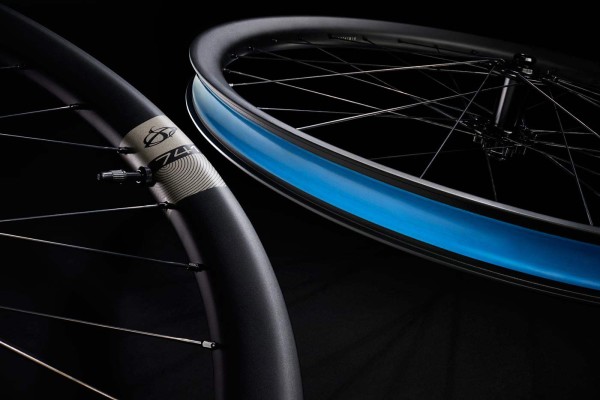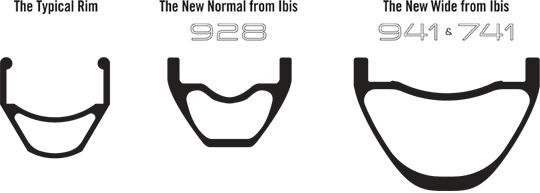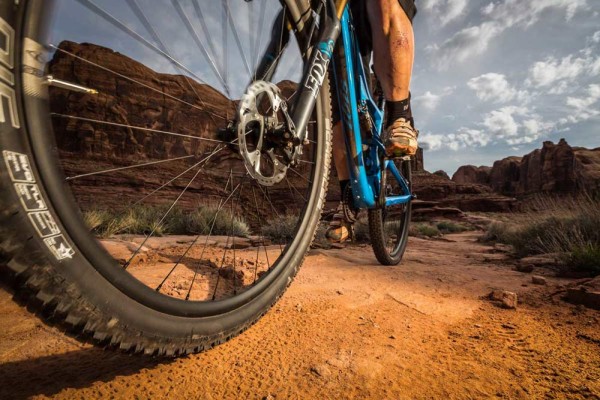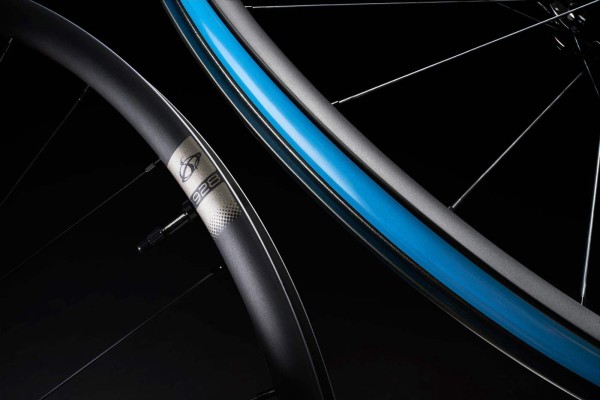 There’s a new industry trend afoot that won’t send you into an apoplectic fit of new-standard-itis. It’s called wider is better and Ibis Cycles wants you do adopt it as the New Normal for a variety of compelling reasons. We’re sure having an OEM spec option for their phenomenal Mojo and Ripley mountain bikes is part of that equation, but we can’t overlook their desire to follow the tenants of the ancient mountain bike proverb – “You can’t have too much traction.”
There’s a new industry trend afoot that won’t send you into an apoplectic fit of new-standard-itis. It’s called wider is better and Ibis Cycles wants you do adopt it as the New Normal for a variety of compelling reasons. We’re sure having an OEM spec option for their phenomenal Mojo and Ripley mountain bikes is part of that equation, but we can’t overlook their desire to follow the tenants of the ancient mountain bike proverb – “You can’t have too much traction.”
In their pursuit of this higher commandment, they looked to their elders and discovered that in a past not long forgotten rims used to be wider. In those earliest days, the defacto rim of choice was the Araya 7x. A rim born for BMX and adapted to 26″ cruiser bikes. They were wide by modern standards (they had a 25mm internal width), but their method of construction was lacking. So early shredders soon discovered the channel section rims were neither light nor strong.
Our distant cousins known as road bikers had already discovered that a box section design offered superior ride dynamics and soon mountain bike legend Keith Bontrager was cutting down Mavic MA2 700c to OG dirt size. While this process brought lightweight rims and the benefits of lower rotational weight to the forefront of mountain biking, the rims began their lives destined for the road and were designed for racing slicks and not big knobbies. Weight being king though, mountain bikers sucked it up and pumped up their tires for the next thirty years.
Today, the proliferation of new materials promises to bring an end to years of compromise. So jump past the break to learn more about why wide rims are better….
For visual learners, Ibis has put together a great video that illustrates the benefits of ultra wide rims, but here’s the short and sweet:
- Dramatically increased traction
- Reduced rolling resistance
- Less tubeless ‘burping’
- Stiffer, stronger wheel
- lighter than most narrow aluminum rims
- Better braking control
- Improved flat protection
- More predictable feel
- You can run a lighter tire with similar durability
- Hookless bead rims are far stronger
- Easy to mount tubeless with just a floor pump
Tech Break Down From Ibis:
Dramatically Increased traction
Wide rims support the tire’s sidewalls better, allowing lower pressures without the tires folding over or burping. This dramatically increases stability and traction. This shows up as faster cornering and braking, better grip in all conditions. How much lower pressure can you go? In general, for a given rider, using tires you’ve used before in a given locale, you will be able to run lower tire pressures with wider rims. How much lower can only be determined through experimentation. Typically, riders are running 4–6 psi less than normal. Light riders on moderate terrain are running as low as 15-17psi.
Tires: Go Big, Go Small
Big – If gravity is your thing, bigger tires and lower pressures equal more traction. The problem is, you can only go so low with large tires on narrow rims before they become unstable. Enter the wide rim. Select the pressure you want without having to over pressurize the tire to control stability and burping.
Not-so-big – If you’re leaning more toward XC use, you can actually go down one tire size and achieve the same or higher levels of traction and performance, only at a reduced overall weight.
Less Tubeless Burping
Wider rims dramatically reduce the incidence of burping. With wider rims the tire sidewall can’t exert as much force on the bead to unseat it and allow air to escape.
Low Pressures Equal Low Rolling Resistance
“Anyone who wants to ride really fast off-road needs to decrease tyre pressure. The rougher the ground, the more pronounced the effect. Traction and comfort increase too,” said Peter Nilges, Editor, Bike Magazine (Germany) Our wide rim profiles provide better sidewall support, allowing you to run lower pressures with no ill effects. More from Peter’s university thesis: “Any such unevenness means that part of the forward propulsion force is required to lift machine and rider upwards. This is equivalent to riding a short uphill grade that requires a certain amount of lifting energy. A tyre with less inflation can adapt to unevenness more easily. The total system needs to be lifted to a lesser degree and less frequently. Resistance is reduced, less power is required.” Read the great article here
Hookless Bead Rims are Far Stronger
Impact damage is the way most carbon rims die. The rim we’ve designed is much stronger in the area where impacts occur since it’s a solid rectangle instead of an inverted “J”. This spreads the impact out over a larger area that is also supported by more material. We tested the impact strength of several major brands of carbon fiber rims and discovered that the change to hookless bead was a major advantage in impact strength. We also optimized the layup to further increase strength. In the end, our rims are 50 to 300% stronger in impact than competing rims we measured. We don’t want to throw anyone under the bus, but we do want you to know that these are well-respected and well-known manufacturers.
Stiffer and Lighter
The switch to carbon fiber as a rim material has allowed us to build a 475 gram 41 mm wide rim, which is lighter than the much smaller and weaker alloy rims it replaces. The 928 is 100g lighter and several times stronger than alloy rims of the same size.
More Predictable Steering
Without wallowing sidewalls, and with dramatic increases in rim stiffness and contact patch area, the front end of the bike feels more precise and firmly planted than it ever did before. The difference is even greater than the improvements that came from tapered steerers and through axles in recent years.
Tire Fit
We’ve carefully sized the bead area so that it’s easy to mount and dismount most tubeless tires by hand. Many tubeless tires will inflate and seat with only a floor pump.
History Repeating Itself
Mountain bike rims were not always narrow. The venerable Araya 7X, a popular rim from the ‘80s, was labeled 26×1.75″ and had an inside width of 25mm. That gives a tire to rim inner ratio of 1.78. A 2.35 tire on a modern 19mm gives a ratio of 3.14, even higher than our 3:1 outlier number mentioned above. A 2.35 tire on our 741 rim results in 1.73:1, back to the original Araya number. Read more about the history on the story tab to the right.
What to Expect
The 41 mm wide rims typically increase the tire width about 3 -5 mm at the widest part of the casing. The diameter stays about the same. The shape of the tread cap will be flatter as well. The 741 and 941 change the shape of the tire and you will want to select a tire that has a good profile on the wider rims. Generally we have found that tires that start with a rounder profile across the tread cap work the best.
The Models
Ibis will be offering three different models available in the aftermarket starting June. Each of these monstrously wide offerings will retail for a very reasonable $1,299. Which is a very reasonable price considering that the weight and that the product is backed by great customer service.  To give you a quick idea of the differences between models, on the left is your typical rim. Pictures in the middle is the 928, they call this the “New Normal” and it has an internal width of 22mm. This is the internal width we’ve seen many companies move towards, for example: the Stan’s Flow EX rim has an internal width of 25.5mm, while the WTB i23 has an internal width of 23mm. A few years ago, those rims where heralded for their internal widths, but companies like Syntace and Derby have pushed the outer limits of what we considered “wide.”
To give you a quick idea of the differences between models, on the left is your typical rim. Pictures in the middle is the 928, they call this the “New Normal” and it has an internal width of 22mm. This is the internal width we’ve seen many companies move towards, for example: the Stan’s Flow EX rim has an internal width of 25.5mm, while the WTB i23 has an internal width of 23mm. A few years ago, those rims where heralded for their internal widths, but companies like Syntace and Derby have pushed the outer limits of what we considered “wide.”
The new 741 and 941 rims from Ibis fall into the realm of the “The New Wide” as they put it, and as you can see pictured on the right, offer a 35mm internal width that dwarfs the offerings of most other competitors. Some of you will note that Derby Rims also manufacturers an ultra wide rim, and you probably won’t be surprised to hear that Ibis liked the idea so much, they funded half the original tooling expense of those rims. According to Ibis, having access to those rims provided invaluable insight. That said, Derby’s rims are made in a different factory due to the higher quantities required by Ibis, but they heartily endorse his product if you’re looking for only rims.
For those who have made it this far, here are the details:

- 41 mm outside, 35 mm inside width, 27.5” / 650b diameter
- 1650g for the set
- rim only 475g
- Wheelset Weight: 1650g (pair)
- SRP: $1299.00 (pair)

- 28 mm outside, 22 mm inside width, 29” diameter
- 1580g for the set
- rim only 375g
- Wheelset Weight: 1580g (pair)
- SRP: $1299.00 (pair)

- 41mm outside, 35 mm inside width, 29” diameter
- 1770g for the set
- rim only 490g
- Wheelset Weight: 1770g (pair)
- SRP: $1299.00 (pair)
The wheels will be built around hubs manufactured in Taiwan to Ibis’s specifications. They feature Enduro bearings and will be available with either a Shimano or SRAM XD driver. They will employ a conventional 32 hole build (using triple butted spokes!), and each of the carbon spoke holes are reinforced with extra carbon, to ensure the rims will not be damaged if a spoke breaks.
Via Ibis

